
Dresden is the capital city of the German state of Saxony and its second most populous city after Leipzig. It is the 12th most populous city of Germany, the fourth largest by area, and the third most populous city in the area of former East Germany, after Berlin and Leipzig. Dresden's urban area comprises the towns of Freital, Pirna, Radebeul, Meissen, Coswig, Radeberg and Heidenau and has around 790,000 inhabitants. The Dresden metropolitan area has approximately 1.34 million inhabitants.

The bombing of Dresden was a joint British and American aerial bombing attack on the city of Dresden, the capital of the German state of Saxony, during World War II. In four raids between 13 and 15 February 1945, 772 heavy bombers of the Royal Air Force (RAF) and 527 of the United States Army Air Forces (USAAF) dropped more than 3,900 tons of high-explosive bombs and incendiary devices on the city. The bombing and the resulting firestorm destroyed more than 1,600 acres (6.5 km2) of the city centre. Up to 25,000 people were killed. Three more USAAF air raids followed, two occurring on 2 March aimed at the city's railway marshalling yard and one smaller raid on 17 April aimed at industrial areas.
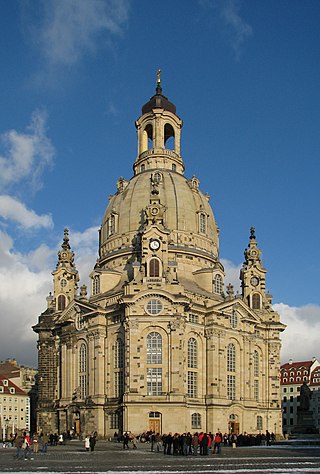
The Frauenkirche is a Lutheran church in Dresden, the capital of the German state of Saxony. Destroyed during the Allied firebombing of Dresden towards the end of World War II, the church was reconstructed between 1994 and 2005.

Günter Blobel was a Silesian German and American biologist and 1999 Nobel Prize laureate in Physiology for the discovery that proteins have intrinsic signals that govern their transport and localization in the cell.

The Berlin Palace, formally the Royal Palace and also known as the City Palace, is a large building adjacent to Berlin Cathedral and the Museum Island in the Mitte area of Berlin. It was the main residence of the House of Hohenzollern from 1443 to 1918. Expanded by order of Frederick I of Prussia according to plans by Andreas Schlüter from 1689 to 1713, it was thereafter considered a major work of Prussian Baroque architecture. The royal palace became one of Berlin’s largest buildings and shaped the cityscape with its 60-meter-high (200 ft) dome erected in 1845.
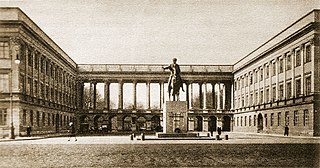
The Saxon Palace was, before World War II, one of the most distinctive buildings in Warsaw, Poland. After the suppression of the 1944 Warsaw Uprising, the palace was destroyed by German armed forces as part of their deliberate destruction of Warsaw.

The Potsdam City Palace is a building in Potsdam, Germany, located on the Old Market Square, next to the St. Nicholas' Church (Nikolaikirche). It was the second official residence of the margraves and electors of Brandenburg, later kings in Prussia, kings of Prussia and German emperors.

The architecture of Germany has a long, rich and diverse history. Every major European style from Roman to Postmodern is represented, including renowned examples of Carolingian, Romanesque, Gothic, Renaissance, Baroque, Classical, Modern and International Style architecture.
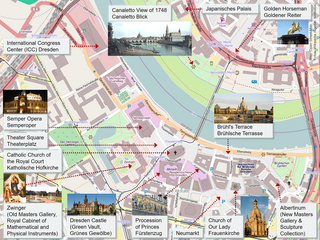
Dresden is a cultural centre in Germany which has influenced the development of European culture. "It is [...] outstanding as a cultural landscape, an ensemble that integrates the celebrated Baroque setting and suburban garden city into an artistic whole within the river valley, and as an example of land use, representing an exceptional development of a major Central-European city."

The Neumarkt is a square and culturally significant section of central Dresden, Germany. The historic area was almost completely wiped out during the Allied bombing during the Second World War. After the war, Dresden fell under Soviet occupation, and later the communist German Democratic Republic, which rebuilt the Neumarkt area in socialist realist style and partially with historic buildings. However, huge areas and parcels of the place remained untilled. After the fall of Communism and German reunification, the decision was made to restore the Neumarkt to its pre-war look.

The Wackerbarth Palace, also known as the Dresdener Ritterakademie, was a palace in Dresden, Germany, built between 1723 and 1729, under the supervision of architect Johann Christoph Knöffel (1686-1752). It was one of the several Baroque palaces in Dresden which were destroyed during the allied bombing raids on February 13, 1945. It was named for Count August Christoph von Wackerbarth (1662-1734), a Saxon minister and Field Marshal. The palace was situated in the city, north of the Elbe river, at the former Beaumontplatz near Neustädter Markt.

Reconstruction in architectural conservation is the returning of a place to a known earlier state by the introduction of new materials. It is related to the architectural concepts of restoration and preservation, wherein the most extensive form of reconstruction is creating a replica of a destroyed building.

The Innere Neustadt is a neighborhood in Dresden within the administrative district of Neustadt. The name is derived from "Neue Königliche Stadt", the name given to the former district of Altendresden when it was rebuilt after a fire before 1732. In contrast to the Äußere Neustadt, the Innere Neustadt was within the city fortifications and, for that reason, is also known as the historic Neustadt. Its population is 7,761 (2020).

The Dresden Panometer is an attraction in Dresden, Germany. It is a venue displaying one of two panoramic paintings of Austrian-born artist Yadegar Asisi inside a former gasometer, accompanied by an exhibition. One of the two panoramas, Baroque Dresden depicts Dresden as it might have appeared in 1756, the other, Dresden 1945 shows the city after it was destroyed during World War II. The Panometer was created in 2006 by Asisi, who coined the name as a portmanteau of "panorama" and "gasometer". In 2003 he had opened a Panometer in Leipzig.
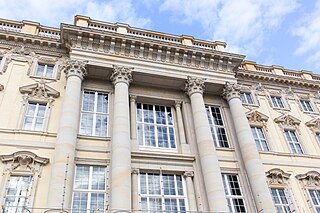
The Foundation for the Humboldt Forum in the Berlin Palace is a German foundation established by the Government of Germany to create the Humboldt Forum museum in the reconstructed City Palace, Berlin. It works closely with the Federal Government Commissioner for Culture and Media. Following a resolution passed by the German Parliament, the Bundestag, it receives funding from the Federal Ministry of Transport, Building and Urban Development.
Initiated in 2005, the global Henry Hope Reed Award or short Reed Award is given to an individual working outside the practice of architecture who has supported the cultivation of the traditional city, its architecture and art through writing, planning or promotion. It is awarded in conjunction with the Driehaus Architecture Prize at the Notre Dame School of Architecture. It is named in honor of architecture critic Henry Hope Reed Jr.

Nikolaus Gromann was an architect of the German Renaissance who served at the court of John Frederick I, Elector of Saxony. He also worked for John Frederick's descendants residing in the cities of Weimar, Gotha and Altenburg, thus spending more than 30 years in the service of the House of Wettin.

The Kulturpalast Dresden is a modernist building built by Wolfgang Hänsch during the era of the German Democratic Republic. It was the largest multi-purpose hall in Dresden when it opened in 1969, and was used for concerts, dances, conferences and other events. The building underwent several years of reconstruction beginning in 2012 and opened with a new concert hall in April 2017.
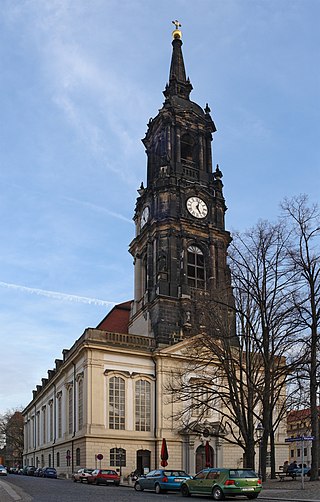
The Dreikönigskirche is a Lutheran church located in the Innere Neustadt of Dresden, Germany. It is the centre of a parish, and a community venue called Haus der Kirche. The church is a listed cultural monument of Dresden.

The reconstruction of the Berlin Palace took place from 2013 to 2020, incorporating donor-funded facades and components of the Baroque palace building. In 2002, the German Bundestag decided to partially rebuild the palace, which was demolished in 1950, thus continuing the restoration of Berlin's Historic Center. The three facades, which date back to 1713 and were designed by Andreas Schlüter, were reconstructed with the palace dome by Friedrich August Stüler from 1853. The project was widely discussed in society. According to the decision of the international expert commission in April 2002, the reconstructed palace serves as the seat of the Humboldt Forum.




















